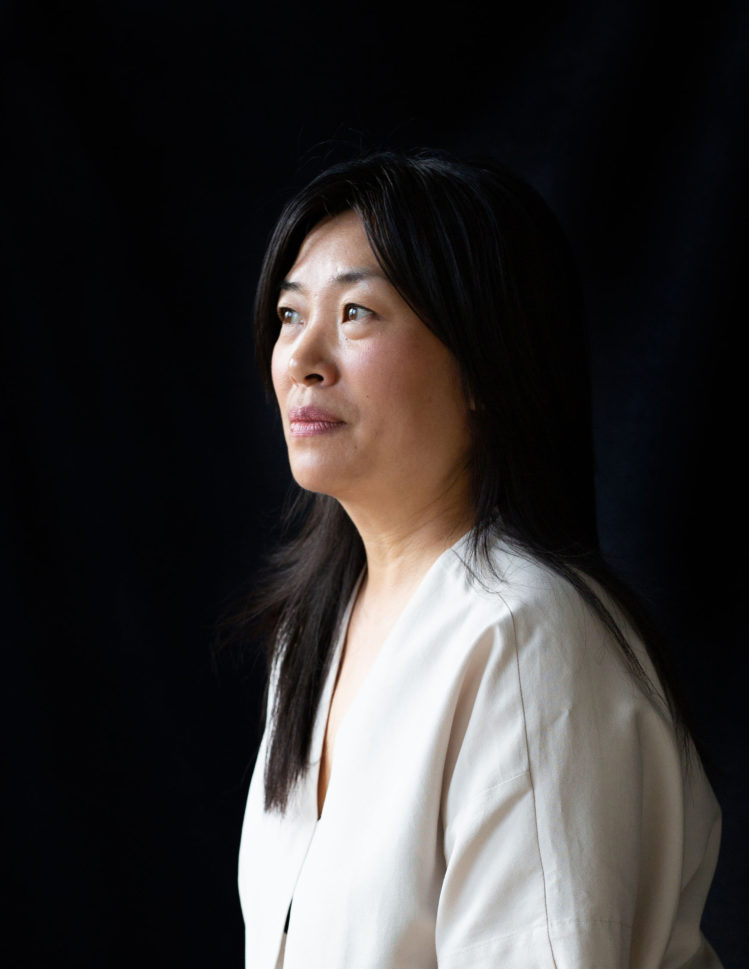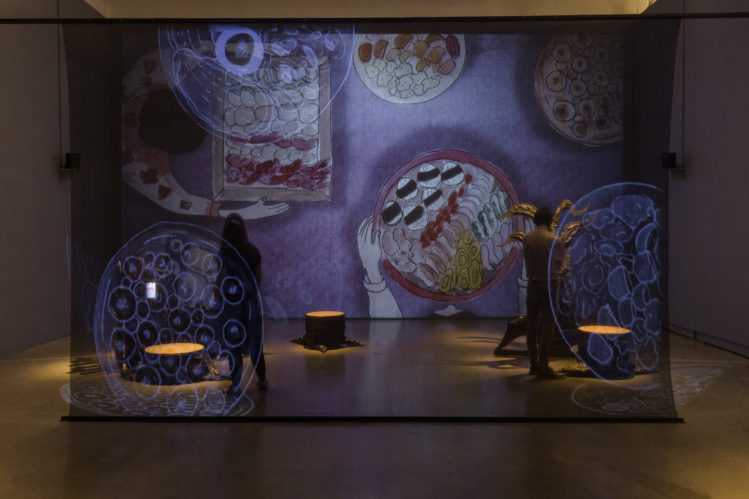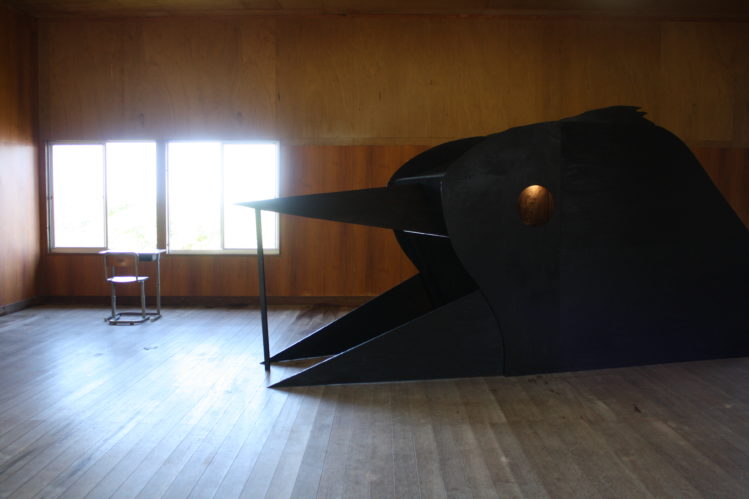In Conversation: Embodied memories and artistic practice
A conversation between artist Cindy Mochizuki and Centre A’s former Curatorial Assistant Intern Alexandra Tsay.

Vancouver-based artist Cindy Mochizuki has exhibited with centre A twice: first in the group exhibition To|From BC Electric Railway 100 years in 2012 and recently in the group show A Lingering Shadow presented at the Polygon Gallery in partnership with Centre A in August 2021. Cindy’s works are devoted to exploring the history of the Japanese diaspora in Canada, the collective and personal memories of the political violence, and the injustice toward the Japanese community. Her works remind me of the shared experiences of diasporic communities around the world in displacement, forced migration, and the beauty of hybrid identities. I have been interested in how art can act as a medium for memory and artistic work with memory for a period of time, and I was delighted to meet with Mochizuki to talk about her artistic practice, the ways she engages with personal and collective memories, and Japanese folklore.
Since the 1970s there has been a ‘memory boom’ in academia with scholars of various disciplines from literary criticism to cultural anthropology engaging with research on collective, personal, and public memories. Memory as a narrative in art has seen growing numbers of artists and practices examining and engaging with the discourses of how and what we remember and forget, what was forgotten, and what should be remembered. Scholars have been producing discourses on critical memory that reflect on collective practices of remembering past injustices to prevent similar events happening in the present or future. Silenced histories are complicated objects to approach. Both structures of public institutions and agencies of researchers, scholars, and activists do the work of repair, remembering, reconciliation. What can art do that cannot be done by other means? Why art?
Cindy Mochizuki: In my practice, I explore and look at the history of Japanese Canadians. I often work with Japanese Canadian seniors. They are now in their 80s or 90s, some of them are part of my family while others are not. These nisei (2nd generation Japanese Canadians or sansei (3rd generation) were in internment camps at the age of three or four years old. Annette Kuhn’s memory work is called to attention here in my practice, where you are actively engaging with remembering and forgetting, my practice has a large part of this process. I often think of the artwork as a creature; there is a face, or the very public side of the art exhibition, but I also have a large part of work that is behind-the-scenes – its backside or tail. As part of this process, I’m meeting with seniors who do not remember or do not want to remember. I do not want to force them to tell stories, but usually, after I start meeting them and building these relationships, I will receive tons of emails and phone calls like “Hi, I am from Hawaii, I want to tell a story about my berry farm in Fraser Valley for your project.” They come to me and share their stories and through this act of sharing and retelling, they are engaging with processes of remembering and transforming these stories.
Alexandra Tsay: I was always curious about how art can be a medium for memory, and one of the reasons memory can be captured through art is probably because memory reflects on the fragility of human beings. We cannot be sure of what we remember or forget – our memories can still be lost no matter how hard we try to preserve them, and it is one of the biggest wonders and joys to have unexpected flashbacks in their full colour. But somehow it is this beauty of memories, why they stay with us and how they stay with us, that through art we can access something that has been lost.
C: Yes – memory is fragile, unstable, slippery. In 2017, I made a video called Lines to Remember as part of a project called dawn to dust and it is of my aunt’s drawing of the house where they lived in Japan after the internment. In the video they draw a house from memory. My father’s family ‘chose’ repatriation after they were in these camps from 1942 to 1946 and after the war was over, the Canadian government had sold their property, so they had nothing to come back to and had two choices: to be paid to get to Japan or east of the Rockies. My grandfather’s family decided to do the forced exile to Japan from 1946 until the early 1960s.
Their bodies were read and perceived as Americans in Japan, and the Americans were seen as enemies during WWII. There was this feeling of unacceptance of these racialized bodies because they were not accepted in Canada, and they were not accepted in Japan. They had found themselves in between both of those cultures, not truly belonging anywhere. For me, when I want to know that history, the history is coming from those bodies. It is an affective, embodied, lived history. It is a memory work that, like memory, is slippery. It can hide some things, but it also reveals something unexpected and very human.
Food and memory

A: When you were talking with people about their life in Fraser Valley for your exhibition Autumn Strawberry (2021), was there something they recollected more often, a recurring theme that came up in people’s stories?
C: A lot of stories that people retold and remembered about their life on the farms in Fraser Valley before the war were about food or food preservation. I have gotten a lot of recipes of what women who ran the farms cooked, or seniors who were kids at that time telling me about what their baachan made, and what tofu tasted like on their farm. One woman came to the studio and shared her tsukemono, Japanese pickles. There was a different recipe and technique each time. I thought it could be a whole new project. Food is such a big part of childhood memories – the warmth and joy of it. I also think that food can be a mode of survival in that case; a lot of mothers would feed eight-plus children and workers and they always planned the cooking and meals. But also, there is a connection between food and memory, and how taste and smell can suddenly evoke a series of memories.
Familial memory or memory transfer inside families
A: Were the descendants of the people with whom you met aware of the stories of their grandparents? Or was it something they had just opened up?
C: They are aware of the project and interested in taking part in the process. Daughters and sons would drop off their elderly parents or also stay for the story sharing. Some of them know these stories in great detail, some vaguely know about the history, and some of the younger generations who took part don’t know a lot about their grandparent’s stories, but are willing to learn and understand. When they see their parents or grandparents talking to me about specific moments or memories, it is an awakening for them as well.
A: There is a kind of generational gap in working with trauma; grandparents or parents may not have shared this with their children because they did not want to traumatize them, or chose to carry on. But they can still transfer their traumatic experience anyway through behaviour, through unspoken means of communication within families, and it is one of the reasons why repair work is still important.
C: I don’t think ‘performance’ is the right word – but there is a strong performative element to memory work. One of the participants brought her mom; the daughter was hesitant and even texted me that her mother would probably not say much and not be helpful to the process. But when we met and asked questions, her mother talked and talked, retelling small details and nuances – she went on for hours. Something happens inside this work. It is very special for me to hear that some participants did not expect to see their parents being so open and willing to tell their story, which I think speaks to the power of art.
Repair work
A: What does repair work mean for you? Is it an opportunity for people to open up, to share, to retell their stories, to live them again, and to feel all those emotions? When it enters the art realm, does it also become the collective repair work as a part of its shared history?
C: As part of Autumn Strawberry we had asked the descendants of some of these storytellers to return back to the installation to work with the choreographer, Lisa Mariko Gelley on simple movement sequences. These sequences were taken from the animations about the stories of their parents or grandparents, which can also be seen and heard in the installation. This aspect of the project re-grounded these embodied memories back into the body in new forms and new energies. The bodies get to return and most importantly play. All of the participants are not performers but there was a collective understanding of why we were there making this work and that there was a collective trust in the process to work through it.
Memory, identity, and Japanese folklore

A: Through your work, it feels like a connection with Japanese culture is important to you. How do you approach Japanese culture and folklore? Are you aiming to activate new meanings there or do you want to create your own versions of mythological stories?
C: I have worked on a few projects in Japan, specifically Yonago, Daisen, and Akita, where I have really explored those aspects of Japanese culture. There have been uncanny situations; when I was a kid I used to have terrifying nightmares here in Vancouver. In my dream, a Buddhist chanting crow would open my mouth, go inside, sit in my head, and chant. These were forms of kanashibari. A few years ago, I was invited to do an artistic residency in Daisen in Tottori-ken. It is a rural village and has heritage sites where they invite artists to produce works and community projects as a means to preserve the heritage of these spaces. It is a small community of artisans and farmers. The curator of the residency wrote to me to say “we are having such a down year and those in the community want you to come and do a project around fortune-telling to uplift the town.” When I arrived in the town, I saw the image of the Karasu Tengu everywhere. He is a character from Japanese folklore that is half-human and half-crow. He is said to be able to shape-shift into a Buddhist monk, is a bit of a trickster, and can bring about change. It was revealed that this region was protected by this figure, and it was that same crow from my childhood nightmares! As a child, I saw and felt a lot of these creatures and cosmologies and it can be based on what and how my parents passed down songs and stories. My father was Japanese Canadian and my mother was born in Osaka and grew up in Yokohama, Japan. Now, as an adult, I came to know these signs as Japanese folklore, but as a child growing up in the Western context, I think you suppress these aspects of Japanese heritage and mythologies or there is no context for them. I was wondering what these dreams were? In that residency, I prepared and read coffee readings for the community and did automatic paintings of what I saw, these paintings were then gifted to each participant. I worked with seniors who harvested organic materials like flowers, plants, et cetera to make a palette of colourful inks. We created a theatrical set of a large Karasu Tengu’s head and I sat with participants who were complete strangers and read their possible futures.
A lot of my work focuses on the past, but then I am also very interested in future tellings, improvisation, divination, and storytelling. During this residency, my drawings for each participant ended up becoming a part of an experimental animation that was more like an archive for the participants to return to. The exhibition took place in an abandoned sake kura, and they would return to the films to find their futures. They called it the archive of the future. Then actually… Years later, three-quarters of those future possibilities came true.
Cindy Mochizuki creates multimedia installation, audio fiction, performance, animation, and drawings. Her works explore the manifestation of story and its relationship to site-specificity, invisible histories, archives, and memory work. She has exhibited, performed, and screened her work in Canada, US, Australia, and Japan. Recent exhibitions include the Vancouver Art Gallery, Burrard Arts Foundation, Richmond Art Gallery, Frye Art Museum, and Yonago City Museum. She was the recipient of the Vancouver’s Mayor’s Arts Award in New Media and Film (2015) and the Jack and Doris Shadbolt Foundation for the Visual Arts VIVA Award (2020).









